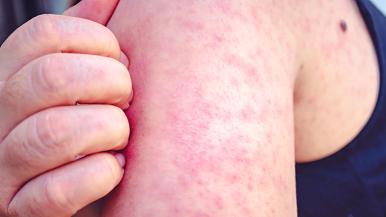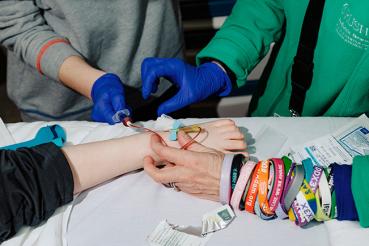Decades after the highly effective measles vaccine stopped the continuous spread of the virus in the United States, measles cases are being reported in Chicago and in other parts of the country. We asked RUSH infectious disease physician David Nguyen, MD, to answer some of the most common questions about the measles virus.
What is measles?
Measles, also called rubeola, is a highly contagious virus that can cause serious illness, and in some rare cases can be fatal. It is very preventable through the measles vaccine. Before a vaccine was available, nearly all children caught measles before they were 15 years old.
What are measles’ symptoms?
The first symptoms — fever and cough followed by red eyes — look very much like a regular cold. After 7 to 10 days, a measles rash develops, starting in the face and spreading down the arms, back, chest and legs.
What does measles look like?
The measles rash is made up of flat red dots that begin to overlap as the rash spreads. While the rash is bright red on light skin, it can be darker brownish red or purplish on darker skin. The rash may have small red bumps as well but most often does not.
Who’s at risk of getting measles?
Anyone who isn’t vaccinated is at risk. That includes babies because the vaccine isn’t usually given before 1 year of age. Also, people who have weak immune systems, such as from HIV or leukemia, may not be protected.
Can adults get measles?
Adults and anyone at any age can get measles if they are not immunized.
How contagious is measles?
Measles is so contagious that among those who are not vaccinated, up to 90% who are exposed to the virus will get it. Measles spreads easily, through droplets in the air and on surfaces. When someone with measles sneezes, the droplets can linger in the air for up to two hours — even after the contagious person has left the room.
It can be hard to know someone has been exposed to measles or has the illness: It takes a week or two after being exposed before the symptoms begin. And then the measles rash doesn’t appear for almost 1week later, so an infected person could spread the illness for several days without knowing they are contagious.
How long are you contagious?
People with measles are contagious beginning about four days before the rash appears and until four days or so after the rash appears. People with weakened immune symptoms may be contagious longer.
How serious is measles?
While the vast majority of measles cases come and go without serious illness, the virus can be severe and cause significant complications. Infants and young children are especially vulnerable to severe illness, as are pregnant women and people whose immune systems are compromised.
For anyone who gets it, measles is miserable to have. The high fever and other symptoms are hard on children and adults. Some cases can be complicated by ear infections, pneumonias, and inflammation of the brain (encephalitis). Worse, measles infection can leave the immune system weakened for weeks or months, making patients vulnerable to other infections.
Can you die from measles?
Complications can be very severe and possibly fatal in the very young, very old or those with weak immune systems or existing illness. Pneumonia is the most common complication in measles-related deaths.
Is measles coming back?
In 2000, after nearly 40 years of effort to vaccinate children, the CDC declared measles eliminated in the U.S. — meaning the virus present in the U.S. had stopped spreading and the only new cases came from people exposed to measles while they were in another country. While more than 93% percent of people in the U.S. are immunized, the nation sees a number of measles cases each year, ranging from fewer than 100 to more than 1,000.
So far this year, measles has infected people in at least 17 states, including Illinois, and it has been seen in Chicago and Cook County.
If so many people are vaccinated, why are there still measles cases?
While 93% is a large number, the CDC says a vaccination rate of 95% is needed to ensure a population is protected from a virus as contagious as measles. While that 95% rate was achieved in the U.S. this century, the rate has slipped in recent years, according to the CDC. Because measles vaccination rates vary from nation to nation across the globe, including in Europe, measles continues to persist in other countries.
Does the vaccine work, and is it safe?
The measles vaccine is protective, long term, in 95 percent of children who receive one dose of it and in 99 percent of those who receive the second dose. It is rare for an immunized person to develop infection if they are exposed to the disease.
Protection from measles vaccination is lifelong.
How do I know if I’m protected against measles?
Your medical record should include vaccines, or your family may have a record. Certain types of employment such as health care settings may have required that you have a record or demonstrated immunity to measles. You may be able to check your vaccination record by visiting the Illinois immunization registry.
If you think it’s possible you were not given the vaccine, you can have your immunity tested, with a “titer” test — a lab test that checks immunity — or you can ask your doctor about getting a dose of the vaccine.
How soon are people protected from measles with the vaccine?
It takes about three weeks after the vaccine dose is received before protection from measles begins.
When do people get the measles vaccine?
The CDC recommends that all children receive a first dose of the combined measles, mumps, rubella vaccine, called MMR, at 12 to 15 months of age and a second dose between the ages of 4 and 6. For families who are traveling outside the U.S. with children younger than 12 months or for other reasons feel their infant will be at increased risk for measles, an early MMR vaccine dose can be administered in children who are as young as 6-months-old, but this will not count toward the recommend two-dose series. Children over age 12 months and adults who are traveling should have two doses, and the doses need to be at least 28 days apart.
You are never too old to get vaccinated if you haven’t already been.




